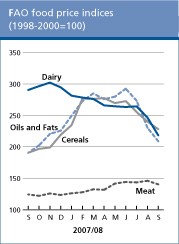|
Rome, Italy
November 6, 2008
World cereal production is
expected to hit a new record this year as high prices boosted
plantings under generally favorable weather conditions, FAO said
today in the latest issue of its "Food Outlook", a bi-annual
commodity publication. World cereal production is forecast to be
large enough to meet anticipated utilization in the short-run,
and help replenish much depleted global stocks.
But the agency warned that the current financial crisis will
affect agricultural sectors in many countries negatively,
including those in the developing world.
 Greater
uncertainty Greater
uncertainty
This year's record cereal harvest and the recent fall in food
prices should, therefore, not create a false sense of security,
said Concepcion Calpe, one of the report's main authors.
"For example, if the current price volatility and liquidity
conditions prevail in 2008/09, plantings and output could be
affected to such an extent that a new price surge might take
place in 2009/10, unleashing even more severe food crises than
those experienced recently," Calpe said.
"The financial crisis of the last few months has amplified
downward price movements, contributed to tighten credit markets,
and introduced greater uncertainty about next year's prospects,
so that many producers are adopting very conservative planting
decisions," Calpe said.
The report stresses that most of the recovery in cereal
production took place in developed countries, where farmers were
in a better position to respond to high prices. Developing
countries, on the contrary, were largely limited in their
capacity to respond to high prices by supply side constraints on
their agricultural sectors.
Implications for the poor
The sharp 2007/2008 rise in food prices has increased the number
of undernourished people in the world to an estimated 923
million. Lower international commodity prices have not yet
translated into lower domestic food prices in most low income
countries.
"There is a real risk that as a consequence of the current world
economic problems people will have to reduce their food intake
and the number of hungry could rise further," Calpe said.
Long-term challenges
The report says that world agriculture is facing serious
long-term issues and challenges that need to be urgently
addressed. These include land and water constraints, low
investments in rural infrastructure and agricultural research,
expensive agricultural inputs relative to farm-gate prices, and
little adaptation to climate change.
To feed a world population of more than nine billion people by
2050 (around six billion today) global food production must
nearly double.
Population growth will take place mostly in developing countries
and for the greater part in urban areas. A shrinking rural work
force will thus have to be much more productive. This will
require more investments in agriculture, machinery, tractors,
water pumps, combine harvesters etc., as well as more skilled,
better-trained farmers and more efficient supply chains. |
|
Facts and figures |
|
World cereal production in
2008/09 is expected to increase
by 5.3 percent, reaching 2.24
billion tonnes.
World wheat production, 677
million tonnes forecast for
2008/09, is expected to hit a
new record following larger
expected crops in Europe, North
America and Oceania.
Higher rice production (450
million tonnes forecast for
2008/09) and decline in world
prices should ease the situation
consumers faced earlier this
year.
World coarse grains production
(forecast 2008/09: 1.11 billion
tonnes) is expected to more than
meet expanded utilization.
Global fish production is
forecast to increase by only one
percent in 2008, sustained by
firm growth in aquaculture. The
difficulties of many banks
heavily involved in the
financing of world capture
fisheries and aquaculture
development are also limiting
credit availability to the
sector.
This year, developing countries
will have born the brunt of
escalated food import costs. The
burden of purchasing food on
international markets for the
most economically vulnerable
countries rose by about one
third from the previous year.
This will be the largest
year-to-year increase on record.
Due to higher food prices, the
number of hungry people rose by
75 million in 2007. |
|